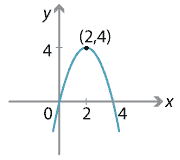Applications to maxima and minima
Since every parabola has a vertex, the \(y\)-coordinate of the vertex gives the maximum or minimum value of \(y\) for all possible values of \(x\).
For example, the vertex of the parabola \(y=4x-x^2\) is \((2,4)\) and the greatest \(y\)-value is 4.

Detailed description of diagram
There are a number of geometric problems and word problems in which the variables are connected via a quadratic function. It is often of interest to maximise or minimise the dependent variable.
Example
A farmer wishes to build a large rectangular enclosure using an existing wall. She has 40 m of fencing wire and wishes to maximise the area of the enclosure. What dimensions should the enclosure have?
Solution

Detailed description of diagram
With all dimensions in metres, let the width of the enclosure be \(x\). Then the three sides to be made from the fencing wire have lengths \(x\), \(x\) and \(40-2x\), as shown in the diagram.
Thus the area \(A\) is given by
\[ A = x(40-2x) = 40x-2x^2. \]This gives a quadratic relationship between the area and the width, which can be plotted.

Detailed description of diagram
Clearly the area will be a maximum at the vertex of the parabola. Using \(x=-\dfrac{b}{2a}\), we see that the \(x\)-value of the vertex is \(x=10\).
Hence the dimensions of the rectangle with maximum area are 10 m by 20 m, and the maximum area of the enclosure is 200 m\(^2\).
Note. Differential calculus can be used to solve such problems. While this is quite acceptable, it is easier to use the procedure outlined above. You may use calculus, however, to solve the following exercise.
